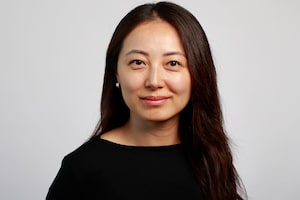
Rachel Wada and Siloh's mural Tempestas.Mavreen David/Handout
This week, more than 30 new murals will be unveiled in eight neighbourhoods across Vancouver as part of the annual Mural Festival.
The murals, painted by 50 artists, include a piece honouring the work of Rosemary Brown, the first Black woman elected to British Columbia’s legislature; a design inspired by the efforts to bring Indigenous leadership together for ocean conversation; and a total transformation of the exterior of an iconic motel, the festival’s largest mural to date.
Andrea Curtis, executive director of the festival, said there’s a lot new about this year’s event after the festival was constrained by COVID-19 health measures for the past two years. But the focal point, she added, is the City Centre Motel serving as the hub this year, with the former 75 motel rooms being converted into low-cost artist studios.
How did the pandemic affect the festival?
It really forced us to think about things in a new way, like everybody else. It forced us to pivot and try new things. The biggest thing for us was breaking out of our home base in the Mount Pleasant neighbourhood. And so in 2020, when the pandemic hit, we realized we weren’t going to be able to do a giant festival in one neighbourhood. And so we spread the love across 11 other neighbourhoods; I think it was nine in 2020. Some of those neighbourhoods now have five, six, seven or more murals. It really does support visitation in those neighbourhoods and put those neighbourhoods on a map in a way where the community feels like they’re being promoted and seen.

Kirk Gower's mural The Blossoming of Compassion.Handout
How has the festival grown over the years?
That’s been really unique. Every year we’ve seen growth, not just in the number of people who come to the festival but in the reach and impact of the work that we do. At first, we really did start as a celebration, and we realized over the years what kind of impact the mural work, or the public artwork and public space work, can have. We’ve really tried to grow our depth of experience and partnerships and working with different stakeholders. This year, one of our big themes is experimenting and placemaking. We’re really wanting to try to let those murals pop off the walls, so to speak, and create these immersive spaces so people can really see how a place can be transformed.
Each year, how do curators decide which art or artists they will choose? What’s the criteria?
We actually have an application process that goes live at the beginning of the year. This year we got over 1,000 applicants. We’re really grateful for the support and the hard work of our guest curators. Every year, our guest curators come in and they go through that list, thoroughly looking for new talent, and bringing new people into the mural scene.
Most of the artists that we work with have never done mural work before, usually around 80 per cent of them. And so we offer them all of the support and training that they need in order to scale their work.
The criteria is very broad; we’re really just looking for work that can be scaled. And that really is just about anything. We have artists who are tattoo artists, we have weavers – Deborah Sparrow herself is a weaver – we have artists that come from so many diverse backgrounds. It really does come down to what the curators are looking for, and also what neighbourhoods we’re working in. Because we have to be responsive to the areas that we’re working in. If we are working in an area that has a particular demographic, we really want to make sure that that’s represented and reflected back.

Caleb-Ellison-Dysart's mural miskinâhk.Mavreen David/Handout
There will be a Low Barrier Arts Program, which aims to support access and remove barriers for folks experiencing low-vision and blindness, neurodiverse folks, and those living with disabilities. Where did that idea come from?
Every year we have a community connected project. It is a really cool new trial project that we’re working on.
A lot of the times, people are approaching us. This community asked us to do a project together. And so we’ve had somebody on our team, working closely with them, and looping them into the festival in a way that felt accessible to them. There are a lot of things that are going on behind the scenes that promote the creative accessibility of art in public spaces to various communities.
Are there any murals that particularly impress you?
It’s a hard one. Not all the murals are done yet, so I can’t pick a favourite really until they’re all finished. But really, I have to say, the transformation in the City Centre Motel is the most exciting thing for me right now, because it’s an immersive space. We’ve painted the ground, the floors, the pillars, all of the walls, and we’re using it as a place to host celebrations. And so you really get to feel just surrounded by the colour and the creation of the three artists that brought that together.
This interview has been edited for length and clarity.
We have a weekly Western Canada newsletter written by our B.C. and Alberta bureau chiefs, providing a comprehensive package of the news you need to know about the region and its place in the issues facing Canada. Sign up today.
 Xiao Xu
Xiao Xu